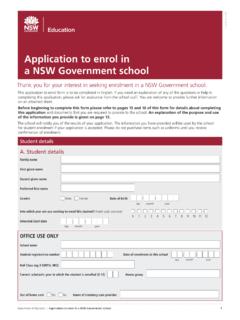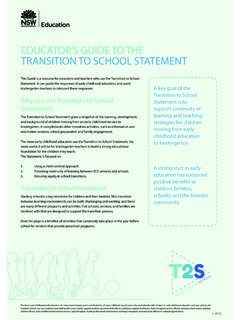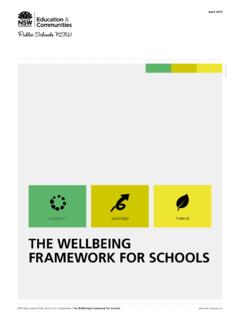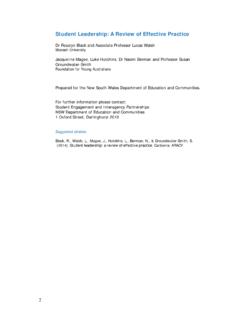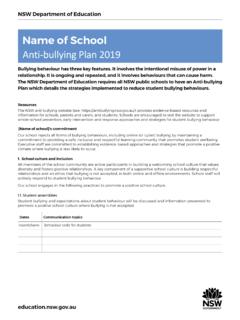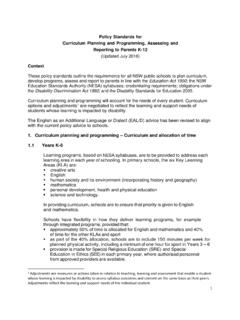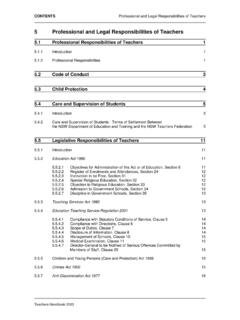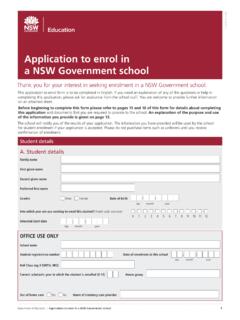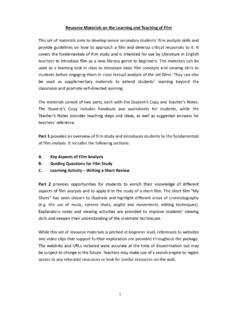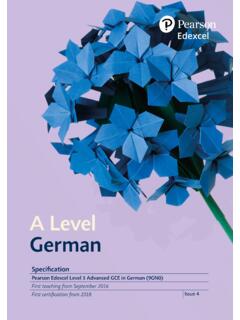Transcription of Text structure and features - education.nsw.gov.au
1 | NSW Department of Education Literacy and Numeracy Teaching Strategies - Reading Text structure and features Stage 5 Overview Learning intention Students will learn to identify specific structural and language features within types of texts . Students will learn to identify genre in a range of imaginative, persuasive and informative texts . Syllabus outcomes The following teaching and learning strategies will assist in covering elements of the following outcomes: EN5-2A: effectively uses and critically assesses a wide range of processes, skills, strategies and knowledge for responding to and composing a wide range of texts in different media and technologies EN5-3B: selects and uses language forms, features and structures of texts appropriate to a range of purposes, audiences and contexts, describing and explaining their effects on meaning Success criteria The following Year 9 NAPLAN item descriptors may guide teachers to co-construct success criteria for student learning.
2 Analyses the use of a persuasive device in an information text identifies the significance of a description in a narrative extract identifies the use of persuasive devices in a persuasive text analyses an argument in a persuasive text identifies the genre of a narrative analyses the structure of a narrative analyses the structure of a persuasive email analyses the structure of a persuasive text identifies the purpose of an exclamation mark in an information text identifies the purpose of inverted commas in an information text identifies the purpose of italicised text in a narrative identifies the purpose of a rhetorical question in a text identifies the purpose of an example in an information text 2 Reading: Stage 5 - Text structure and features National Literacy Learning Progression guide Understanding texts (UnT9-UnT11) Key.
3 C=comprehension P=process V=vocabulary UnT9 compares and contrasts the use of visual elements in multimodal texts with similar purposes (C) interprets and integrates visual, auditory and print elements of multimodal texts (C) uses knowledge of a broader range of cohesive devices to track meaning (paragraph markers, topic sentences) (see Grammar) (P) analyses how language in texts serves different purposes (identifies how descriptive language is used differently in informative and persuasive texts ) (see Grammar) (P) UnT10 evaluates the effectiveness of language forms and features used in moderately complex or some sophisticated texts (C) applies and articulates criteria to evaluate the structure , purpose or content of a text (P) UnT11 critically evaluates the use of visual elements in multimodal texts on the same topic or with similar purposes (C) navigates digital texts to efficiently locate precise information that supports the development of new understandings (P)
4 Teaching strategies Tasks Appendices Analysing persuasive texts Analysing nonfiction texts Appendix 1 - Match and sort Appendix 2 - features in non-fiction texts Analysing text features in a nonfiction text Appendix 3 - Analysing the effects of text features Appendix 4 - Purpose and structure of non-fiction texts Analysing a website Appendix 5 - Hierarchy chart Analysing narrative texts Appendix 6 - Match and sort Appendix 7 - Identifying structure in narrative texts Structuring language in an imaginative text Appendix 8 - Key grammatical terms Appendix 9 - Close analysis of a paragraph in an imaginative text Compile an annotated Reading Magazine . Appendix 10 - Identifying structural and language features of a narrative NSW Department of Education, Nov-21 3 Background information Types of text Classifications of text are made according to the particular purposes texts are designed to achieve.
5 These purposes influence the characteristic features the texts employ. In general, texts can be classified as belonging to one of three types (imaginative, informative or persuasive), although it is acknowledged that these distinctions are neither static nor finite and particular texts can belong to more than one category. Imaginative texts These texts include novels, traditional tales, poetry, stories, plays, fiction for young adults and children, including picture books and multimodal texts such as film. Informative texts These include texts which are valued for their informative content, as a store of knowledge and for their value as part of everyday life. For example, information reports, news articles and reference materials.
6 Persuasive texts These include student essays, debates, arguments, discussions, polemics, advertising, propaganda, influential essays and articles. Theme Refers to the central or one of the main underlying ideas or messages of a text. Genre The categories into which texts are grouped. The term has a complex history within literary and linguistic theory and is often used to distinguish texts on the basis of, for example, their subject matter (detective fiction, romance, science fiction, fantasy fiction) and form and structure (poetry, novels, short stories). Text structure The ways information is organised in different types of texts , for example chapter headings, subheadings, tables of contents, indexes and glossaries, overviews, introductory and concluding paragraphs, sequencing, topic sentences, taxonomies, cause and effect.
7 Choices in text structures and language features together define a text type and shape its meaning (see language features ). Textual form The conventions specific to a particular type of text, often signaling content, purpose and audience, for example letter form, drama script or blogs. Language features The features of language that support meaning, for example sentence structure , vocabulary, illustrations, diagrams, graphics, punctuation, figurative language. Choices in language features and text structures 4 Reading: Stage 5 - Text structure and features together define a type of text and shape its meaning (see structures of texts ). These choices vary according to the purpose of a text, its subject matter, audience and mode or media of production.
8 Reference: English K-10 Syllabus NSW Education Standards Authority (NESA) for and on behalf of the Crown in right of the State of New South Wales, 2012. Where to next? Audience and purpose Author bias and perspective Main idea and theme Overview of teaching strategies Purpose These literacy teaching strategies support teaching and learning from Stage 2 to Stage 5. They are linked to NAPLAN task descriptors, syllabus outcomes and literacy and numeracy learning progressions. These teaching strategies target specific literacy and numeracy skills and suggest a learning sequence to build skill development. Teachers can select individual tasks or a sequence to suit their students.
9 Access points The resources can be accessed from: NAPLAN App in Scout using the teaching strategy links from NAPLAN items NSW Department of Education literacy and numeracy website. What works best Explicit teaching practices involve teachers clearly explaining to students why they are learning something, how it connects to what they already know, what they are expected to do, how to do it and what it looks like when they have succeeded. Students are given opportunities and time to check their understanding, ask questions and receive clear, effective feedback. This resource reflects the latest evidence base and can be used by teachers as they plan for explicit teaching.
10 Teachers can use assessment information to make decisions about when and how they use this resource as they design teaching and learning sequences to meet the learning needs of their students. Further support with What works best is available. Differentiation When using these resources in the classroom, it is important for teachers to consider the needs of all students, including Aboriginal and EAL/D learners. NSW Department of Education, Nov-21 5 EAL/D learners will require explicit English language support and scaffolding, informed by the Enhanced EAL/D enhanced teaching and learning cycle and the student s phase on the EAL/D Learning Progression. Teachers can access information about supporting EAL/D learners and literacy and numeracy support specific to EAL/D learners.
